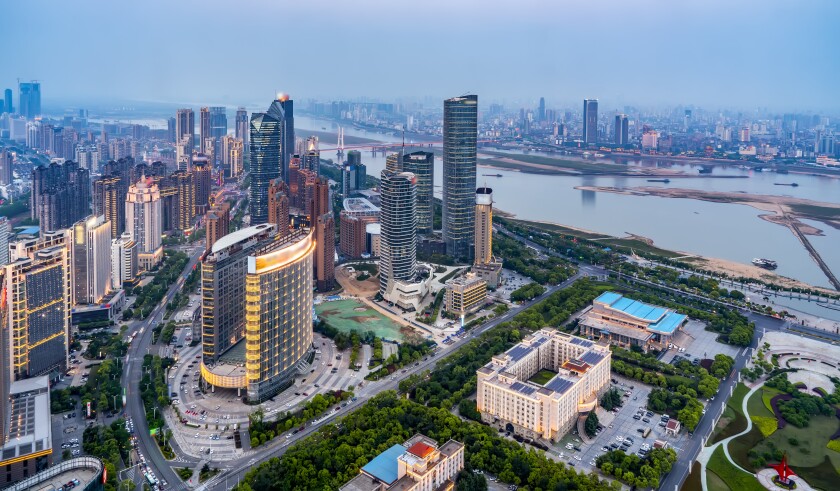Global investors are increasingly paying more attention to bonds they had long been critical about: debt sold by Chinese local government financing vehicles (LGFVs).
These borrowers tend to be the backbone of their regional governments and come with de facto state backing — plenty appealing compared to the beleaguered privately-owned property developers that had traditionally satiated yield-hungry investors but are now facing financial distress.
But in their pursuit of yield, are investors overlooking some obvious red flags from LGFVs?
Since the start of the year, 81 primary bond deals from LGFVs have been priced in the Asia dollar market, raising a combined $11.5bn, according to CreditSights.
During the same period, Chinese corporations in total — excluding sovereign, quasi sovereign and financial credits — raised a total $17.5bn from 103 bond deals. This means about 66% of the China corporate bond volume so far in 2021 has come from LGFVs, or nearly 80% by deal numbers.
The proportion is significant — and only likely to grow as LGFVs have a record $31.4bn of offshore bonds maturing in 2022.
Investors are paying attention. GlobalCapital Asia understands that a larger pool of institutional investors and private banks is now circling LGFVs in a bid to seek higher returns.
After all, with property credits all but shut out from the international debt market, investors wanting returns have to find other sources.
It is little wonder then that LGFV supply remains unabated. Mostly tucked in the three year bucket, LGFV bonds are being priced competitively even though the deals often ride on support from friend-and-family investors or are hard underwritten by bookrunners.
But a big question still remains: how safe is the LGFV market after all?
Pros and cons
The credit history of LGFVs has been a mixed bag — and somewhat chequered. While some issuers are strong as they hail from rich provinces, many others lag on credit metrics. One thing, however, is common between all of them — hidden debt.
Beijing has been trying hard to deleverage its state-backed entities at both central and local levels, but the numbers still remain high.
The total debt — official and hidden — at local governments equates to 66% of China’s GDP, according to Nomura’s estimates. With land sales, where LGFVs made handsome profits due to joint ventures with property companies, likely to drop by 25% this year and expected to fall in the future due to the slowing China economy, the pressure on debt will only increase.
The start of 2022 was also politically sensitive. China held its annual parliamentary Two Sessions meetings in early March, pushing Beijing to go easy on any erring LGFVs. That stance may very well change, though.
Investors cannot be blamed for pursuing LGFVs. After all, these look attractive on many fronts. Several LGFVs are still investment grade rated due to implicit government support. LGFV bonds also continue to deliver much better, and positive, returns in 2022 despite nearly 70% of the property sector bonds trading below 70s or lower.
Due to the run up in US Treasuries, the average yield on LGFVs is now around 3.5% or higher. For investment grade-rated credits, this level can be attractive for many investors.
LGFVs also score some brownie points on another front. The borrowers have not defaulted on any of their offshore and onshore public bonds, even pipping state-owned enterprises that have defaulted on offshore dollar debt.
But the recovery rate on SOE defaults varies significantly and should be a cue for investors.
Bondholders also shouldn’t turn a blind eye towards defaults happening in other pockets of LGFVs.
While LGFVs haven’t defaulted on public bonds, the same cannot be said for their trust loans. As recently as last week, an LGFV in the Lanzhou city in Gansu province is said to have failed to repay interest on a guaranteed trust loan.
It is unclear if the non-repayment is already a default in the absence of a grace period, but the event does warrant some scrutiny. The parent, Lanzhou Construction Investment, has a $300m bond due in November, trading in the low 80s range.
Critics can argue that non-repayment of a trust loan may not be a pre-cursor for a dollar bond default. But simply brushing this aside due to a belief that LGFVs are safe because of government backing can be a dangerous stance.
Slowing land sales has been increasing pressure on regional governments and their funding vehicles. Moody’s last week said that six of the 49 LGFVs rated by the agency face funding constraints because of heavy reliance on the land market. The adverse impact could be wider and may last longer due to the property sector’s downturn.
Despite these odds, LGFVs do show resilience, which can be attributed to support handed down by the central government.
For instance, the money transfers promised by the central government to local and regional governments in 2022 is the highest in the past 10 years. The amount equals Rmb9.8tn, up 18% annually, indicating preference for LGFVs. Yet, at the micro level, the allocation of central transfers may vary, and could impact individual credits immensely.
The devil could be in the detail. It’s time investors step back and assess risks towards LGFVs with a fresh perspective.

